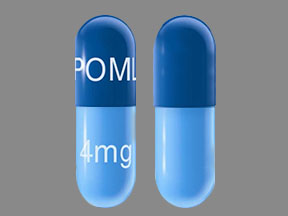Pomalyst Dosage
Generic name: POMALIDOMIDE 1mg
Dosage form: capsule
Drug classes: Miscellaneous antineoplastics, Other immunosuppressants
Medically reviewed by Drugs.com. Last updated on Mar 24, 2023.
Pregnancy Testing Prior to Administration
Females of reproductive potential must have negative pregnancy testing and use contraception methods before initiating POMALYST [see Warnings and Precautions (5.1) and Use in Specific Populations (8.1, 8.3)].
Recommended Dosage for Multiple Myeloma
The recommended dosage of POMALYST is 4 mg once daily orally with or without food on Days 1 through 21 of each 28-day cycle until disease progression. Give POMALYST in combination with dexamethasone [see Clinical Studies (14.1)].
Recommended Dosage for Kaposi Sarcoma
The recommended dosage of POMALYST is 5 mg once daily taken orally with or without food on Days 1 through 21 of each 28-day cycle until disease progression or unacceptable toxicity. Continue HAART as HIV treatment in patients with AIDS-related Kaposi sarcoma (KS) [see Clinical Studies (14.2)].
Dosage Modifications for Hematologic Adverse Reactions
Multiple Myeloma: Dosage Modifications for Hematologic Adverse Reactions
Initiate a new cycle of POMALYST in patients with multiple myeloma (MM) when the neutrophil count is at least 500 per mcL and the platelet count is at least 50,000 per mcL.
Dosage modification for POMALYST for hematologic adverse reactions in patients with MM are summarized in Table 1.
| Adverse Reaction | Severity | Dosage Modification |
|---|---|---|
| * Permanently discontinue POMALYST if unable to tolerate 1 mg once daily. ANC= absolute neutrophil count |
||
|
Neutropenia [see Warnings and Precautions (5.5)] |
|
|
|
|
|
|
Thrombocytopenia [see Warnings and Precautions (5.5)] |
|
|
|
|
|
Kaposi Sarcoma: Dosage Modifications for Hematologic Adverse Reactions
Initiate a new cycle of POMALYST in patients with KS when the neutrophil count is at least 1000 per mcL and the platelet count is at least 75,000 per mcL.
Dose modifications for POMALYST for hematologic adverse reactions in patients with KS are summarized in Table 2.
| Adverse Reaction | Severity | Dosage Modification |
|---|---|---|
| * Permanently discontinue POMALYST if unable to tolerate 1mg once daily. ANC= absolute neutrophil count |
||
|
Neutropenia [see Warnings and Precautions (5.5)] |
ANC 500 to less than 1,000 per mcL |
Day 1 of cycle
During cycle
|
|
ANC less than 500 per mcL |
|
|
|
Febrile Neutropenia [see Warnings and Precautions (5.5)] |
ANC less than 1,000 per mcL and single temperature greater than or equal to 38.3°C |
|
|
Thrombocytopenia [see Warnings and Precautions (5.5)] |
Platelet count 25,000 to less than 50,000 per mcL |
Day 1 of cycle
During cycle:
|
|
Platelet count less than 25,000 per mcL |
Permanently discontinue POMALYST. |
|
Dosage Modifications for Non-Hematologic Adverse Reactions
Permanently discontinue POMALYST for angioedema, anaphylaxis, Grade 4 rash, skin exfoliation, bullae, or any other severe dermatologic reaction [See Warnings and Precautions (5.7, 5.12)].
For other Grade 3 or 4 toxicities, hold treatment and restart treatment at 1 mg less than the previous dose when toxicity has resolved to less than or equal to Grade 2 at the physician's discretion.
Dosage Modifications for Strong CYP1A2 Inhibitors
Avoid concomitant use of POMALYST with strong CYP1A2 inhibitors. If concomitant use of a strong CYP1A2 inhibitor is unavoidable, reduce POMALYST dose to 2 mg [see Drug Interactions (7.1) and Clinical Pharmacology (12.3)].
Dosage Modification for Severe Renal Impairment on Hemodialysis
Take POMALYST after completion of dialysis procedure on hemodialysis days [see Use in Specific Populations (8.6) and Clinical Pharmacology (12.3)].
- •
- For patients with MM with severe renal impairment requiring dialysis, reduce the recommended dosage to 3 mg orally daily.
- •
- For patients with KS with severe renal impairment requiring dialysis, reduce the recommended dosage to 4 mg orally daily.
Dosage Modification for Hepatic Impairment
Multiple Myeloma
For patients with MM with mild or moderate hepatic impairment (Child-Pugh A or B), reduce the recommended dosage to 3 mg orally daily.
For patients with MM with severe hepatic impairment (Child-Pugh C), reduce the recommended dosage to 2 mg [see Use in Specific Populations (8.7) and Clinical Pharmacology (12.3)].
Kaposi Sarcoma
For patients with KS with mild, moderate, or severe hepatic impairment (Child-Pugh A, B, or C), reduce the recommended dosage to 3 mg orally daily [see Use in Specific Populations (8.7) and Clinical Pharmacology (12.3)].
More about Pomalyst (pomalidomide)
- Check interactions
- Compare alternatives
- Pricing & coupons
- Reviews (3)
- Drug images
- Side effects
- During pregnancy
- FDA approval history
- Drug class: miscellaneous antineoplastics
- Breastfeeding
- En español
Patient resources
Professional resources
Related treatment guides
Further information
Always consult your healthcare provider to ensure the information displayed on this page applies to your personal circumstances.


